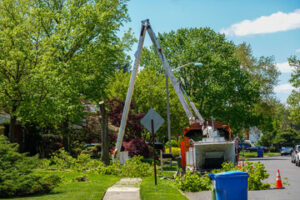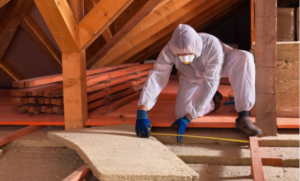Trees require maintenance to foster strength, longevity, and expansion. A skilled arborist can provide pruning and trimming services to keep trees healthy.

In addition, he or she can identify invasive plants that are displacing native plants. Arborists also apply pruning standards and adhere to standardized safety procedures. Contact Hummingbird Tree Care LLC for professional help.
Trees are a substantial investment for many property owners, adding value in the form of shade, beauty and privacy. But a lack of monitoring and care can transform even healthy trees into looming hazards that pose threats to people, vehicles or buildings.
To avoid a costly problem, property owners should inspect their trees and shrubs on a regular basis, particularly during the transitional seasons. This will allow them to catch problems before they progress. Check for symptoms like insect pests, fungus, unseasonal shedding and limbs that appear to be struggling or dead.
Some problems are easy to spot, while others may be difficult to identify from the ground. For example, a tree with bare branches or trunk bark that is discolored or showing signs of mold or mildew may indicate disease, and immediate pruning or treatment is recommended. Other issues may be more severe, such as a leaning or cracked trunk, root disturbance or girdling roots, which could cause the collapse of the tree and create safety concerns.
Other potential problems include soil conditions, such as nutrient deficiencies or compacted soil that limits the tree’s ability to absorb moisture and nutrients. Pests, such as insects and fungi, can also damage a tree’s health by attacking its defenses or causing additional stress or decline. However, applying a spray for a pest infestation without properly identifying the cause of the problem can often do more harm than good.
In addition, property owners should look for signs of wildlife interference that can damage a tree by browsing or gnawing on leaves, bark or roots. This can lead to the deterioration of tree tissue, abrasions and cuts, and ultimately limb failure or death.
Keeping Trees Healthy
Trees are a beautiful addition to any landscape, but they require a lot of work and upkeep to stay healthy. Proper care includes pruning to promote healthy growth, fertilization, watering, pest and disease management, and protecting against damage and injury from weather conditions like high winds and heavy rains.
Many common diseases plague trees all year round, from fungal pathogens that disrupt a tree’s ability to transport nutrients and water to the leaves, to serious issues such as Dutch Elm Disease (DED), which can destroy entire forests of American elms in just one season. DED is caused by an aggressive fungus that attacks the trunk and root system of affected trees, interfering with the flow of vital nutrients and water.
Stress factors, such as drought and overcrowding, can also compromise a tree’s health, opening the door to infection. Likewise, wounds on the stem and roots can invite disease by creating points of entry for pathogens.
Invasive species, such as vines, are another common problem that can severely affect a tree’s health and lead to structural weakness or even death. A proper invasive species control plan should be implemented by a qualified arborist to protect the overall health of your trees and the surrounding plant life.
By taking the time to observe your trees and pay attention to any changes, you can ensure that your landscape will remain beautiful and healthy for generations to come. Remember, that your trees are a long-term investment and any time you spend caring for them will be paid back in beauty, shade, and the benefits they offer to our environment. By staying on top of your maintenance needs and working with a professional, reputable tree service provider like Hansen’s Tree Service, you can rest assured knowing that your trees will be well-maintained throughout the seasons.
Getting Started
Starting a tree service company is a great business opportunity that can provide you with a steady stream of revenue. However, it’s essential that you take the time to plan your business, establish a budget, and acquire the proper licensing, insurance, and certification. This will allow you to start your company with a solid foundation and increase your chances of success.
A good tree care specialist understands all aspects of trees, including their biology, soil, insects, fungus, diseases, and the effects of weather on them. A strong understanding of these factors will help you ensure that your clients’ trees are healthy and that they have the potential to live long lives.
It’s also important to consider how you will market your tree services. The best way to generate customers is through word-of-mouth referrals. However, it’s also necessary to invest in marketing tools such as a professional website and invoicing software. This will help you attract new clients and improve customer satisfaction.
Once your business is established, it’s important to maintain a high level of customer service. This will not only encourage repeat business but will also help you build a positive reputation in the community. A dedicated customer service team can also assist you with the marketing and sales processes by answering customer questions and generating leads.
The last step in getting started in tree care is to make sure that you have the proper equipment for your business. This includes a chainsaw, stump grinder, chipper, vehicle for transporting equipment, and safety gear. It’s also a good idea to purchase liability insurance for your tree care business. This will protect you from personal liability in case something goes wrong while working on a job site.
Insurance
Insurance may seem like just another business expense but it’s one that’s critical for tree service businesses. All the sweat equity and money invested in a tree care business can be erased if a lawsuit or liability claim occurs. Many clients will not work with a tree-trimming company that isn’t insured. And even if state laws don’t require it, insurers view insured tree services as more reputable and professional than those that aren’t.
General liability insurance helps pay for third-party accidents that occur during tree work, such as a property owner tripping over an arborist’s equipment or a client’s yard getting destroyed by falling debris. Typically, it’s bundled with commercial auto insurance for savings in a business owners policy (BOP). Errors and omissions, or E&O, is a wise addition to general liability for tree service companies. It protects against claims resulting from poor advice or recommended services that lead to financial loss for clients.
Workers’ compensation is required for all tree service companies with employees and it protects you as the property owner if an employee gets injured at your home during the course of their work. Look for a tree company with workers’ comp that specifies trees as the type of work being performed. Many standard workers’ comp policies will only cover landscapers or other types of construction-related work.
Lastly, ask potential tree service contractors about their experience, training and background. They should also be able to provide you with a copy of their liability, property damage and workers’ compensation insurance. If they have trouble providing this information or try to give you an expired certificate of insurance, it’s best to find a different tree service professional.
Marketing
Whether you offer tree service, landscaping or lawn care, or plant health care, marketing can help you find and convert more business. It can also help you stay top of mind for those in need of your services, and to distinguish yourself from other competitors.
Start by identifying who your ideal customers are, or buyer personas. These are fictional, generalized representations of people who you know will be interested in your services and who can serve as a guide when choosing marketing strategies. For example, a buyer persona might be an older, wealthy, urban homeowner who wants to maintain the health of their mature trees. It could also be a young family that wants to add curb appeal by installing a new deck, or an arborist looking for a quality tree removal company for his or her next project.
Establish trust with potential customers by showcasing testimonials and reviews on your website. Include dramatic before-and-after photos to illustrate your work and the impact it has on your clients’ properties. Share these on social media and in your advertising campaigns.
Get listed in local directories to boost your visibility in your community and on Google searches. Update these listings regularly and remember to keep your address, phone number and other relevant information current. Adding a map to your listing can increase your chances of showing up in local search results. Ensure your photos are uploaded properly. Avoid using generic data tracking numbers and rename file names to include specific cities, neighborhoods or services, which helps Google identify the relevance of your photos and categorize them correctly.
Implementing these marketing strategies will improve your business’s online visibility, grow brand awareness, and attract more qualified leads. It will also allow you to showcase your expertise and position yourself as a leader in the industry.








